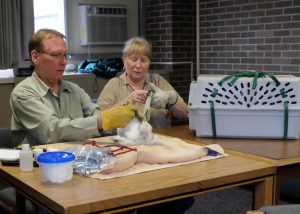There’s more than just Easter eggs this month
UWO’s peregrine falcons just laid some of their own
Webcam screenshot — One of the four eggs laid by a peregrine falcon that is nesting on top of Gruenhagen Hall is visible on the box’s webcam.
April 12, 2023
There are now four eggs in the peregrine falcon box on top of Gruenhagen Conference Center at UW Oshkosh, which has been home to a nesting pair of falcons since 2011.
In that year, Wisconsin Peregrine Falcon Recovery Project founder Greg Septon was contacted by a UWO faculty member about the possibility of building a nesting box on campus, as there were reports of falcons in the area.
UWO partnered with Septon’s initiative, and the first pair of falcons moved in. Named Hondo and Deborah, they hatched three chicks in spring 2011.
The four eggs currently in the nesting box are expected to hatch later this month. A live stream of the falcon’s box can be watched at bit.ly/419BzDu.
Roughly three months after they’re born, the chicks are given leg bands with a letter and number combination, which are then tracked and used for research.
Dana Hartel, a UWO faculty member who helps tag the falcons, said that the chicks are securely removed from the box and leg bands are placed onto them. By this point, the chicks have reached their adult size and won’t be harmed by the bands. After this, the chicks are returned to the box.
Hartel said she became involved partly because she has a great interest in falcons.
“I happened to meet [Septon] at an event and then was able to make contacts on campus to get involved in cleaning the box after talking with him,” she said. “Since then, I have also been involved in the campus arrangements when [Septon] determines the date for the banding each year.”
UWO Sustainability Director Bradley Spanbauer said artificial nesting spots like the Gruenhagen box help address habitat preservation, especially an urbanized environment like Oshkosh.
“As we pull or remove strands in the web of life, especially at the alarming rate humans are doing so, we are creating instability in natural systems that hold the biosphere together,” he said.
Spanbauer said the box attracts peregrines because it resembles natural nesting spots.
“By establishing nest boxes in high places we are creating an ideal nest site in a human-dominated landscape that mimics where falcons may nest naturally,” he said.
The nesting box not only balances predator vs. prey dynamics, but it can also make conservation fun, since the Gruenhagen box is constantly live streamed.
“You can watch almost the entire life cycle of these peregrine falcons — courtship, mating, laying of eggs, hatching, feeding, etc.,” he said.
The peregrine population in the U.S. was declining due to the chemical Dichlorodiphenyltrichloroethane (DDT), an agricultural insecticide that first saw use in the 1940s.
The chemical caused peregrine eggs to become thin and break during incubation.
DDT was eventually banned in 1972, but so much of the chemical had accumulated within the falcon population that human intervention was necessary. The species was added to the endangered list in 1970.
On top of this, habitat destruction was also taking place, so artificial nesting boxes were constructed and placed high atop buildings and other structures where peregrines lived.
Septon, who has spent the last few decades revitalizing the falcon population, said he became interested in the species from a young age and was involved in falconry as a highschooler.

“When I was growing up, there were no peregrines nesting in Wisconsin; they were listed as endangered, and I’d often daydream during class about ways to bring them back,” he said.
While working at the Milwaukee Public Museum in 1986, Septon initiated the peregrine recovery program, which included raising funds and public interest, as well as coordinating the first releases of captive-produced young falcons in Milwaukee.
Septon said that he’s overseen the construction of approximately 50 nesting boxes across Wisconsin, which provide the best chance for the falcons to see adulthood.
“The nest boxes provide a safe, protected space for peregrines to nest in the built environment,” he said. “They can and do nest on structures without nest boxes at times but these sites often fail; eggs can roll off buildings, nests can get flooded out, young can fledge prematurely and end up dead on the ground, etc. So the boxes greatly increase nest success.”
According to a 2022 nesting report, there was a known minimum total of 113 young produced at 39 successful nest sites. The total number of successful nests was down 9.3% compared to 2021, and the overall production was down 7.4%.
Septon said he believes that the Midwest population has stabilized and is expanding as the falcons reoccupy many of their natural nesting sites. Still, he said the artificial sites are important, as 50% of the Wisconsin-born peregrines were born at power plants over a 20-year span.
“Nearly 70% of the successful peregrine nests last year were still associated with the human built environment,” he said. “If we stopped managing this segment of the population, peregrines would again be in trouble … They still have fully adapted to the built environment and will forever be part of it, so managing these sites will remain important.”
Before the widespread use of DDT, there were about 40 pairs of peregrine falcons in the Midwestern United States, according to Septon’s initiative. By 2003, that number jumped to 128 pairs.
Moving forward, Septon said he’s hoping for others to come forward and help protect and grow the falcon population.
“My hope is that there will be someone with the same passion, determination, dedication and drive to come along and help ensure that peregrines will continue to be a vital part of our urban and natural world,” he said. “[One of my biggest accomplishments is] having been able to stick to this long-term, so we’re where we’re at today, and knowing I can now take people to places where they can see peregrines — something I could never experience as a kid.”















